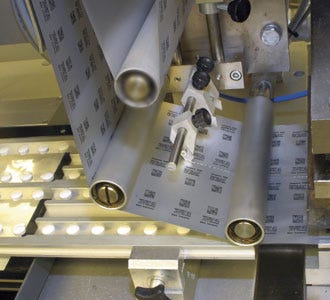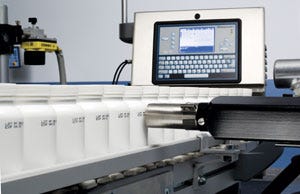How serialization can reduce pharma counterfeiting 3561
January 29, 2014

|
The benefits of serialization are almost limitless when it comes to retreiving data, maintaining consumer safety and establishing a brand identity. |
Serialization has received a great deal of visibility recently, particularly given recent efforts in the U.S. and Europe to tighten up the supply chain to combat counterfeiting. This is an issue which is important in a wide variety of industries, but most especially in the pharmaceutical industry where counterfeiting and diversion can cause consumer safety issues, not to mention the burden of cost placed on developers when returns and recalls become necessary. Fortunately, new technologies based on package serialization have been developed to address issues such as counterfeiting and traceability. Serialization now provides brand owners with increased security and protection from counterfeiters and diverters, as well as supply chain efficiency, returns management and innovative consumer education and marketing programs.
What does serialization mean?
Serialization refers to the assignment and placement of unique markings on a primary package. These markings can be a two-dimensional or RSS bar code, a human-readable letter/number code or unique serialized codes that can be “written” onto a radio-frequency identification (RFID) tag/label. These unique codes are placed on each package when they are packaged using variable data printers or preprinted labels or cartons and then read by a vision system. These unique codes are uploaded to an event repository database that can be accessed by various parties, including pharmacists, law enforcement officials and even consumers after the product is shipped and sold. The individual packages can be aggregated or electronically linked to a shipping case, and even to a pallet by putting unique codes on these other levels of packaging, thus creating a child/parent/grandparent relationship. As a result of this aggregation, if the bar code on a pallet is scanned at a warehouse, the brand owner or trading partner will have tracking information regarding all shipping containers and primary containers at that warehouse. Additionally, once ePedigree laws take effect, serialization and aggregation will provide the ability to track-and-trace products from the point of packaging to the pharmacy or healthcare facility.
Governmental requirements
As safety concerns grow, regulatory agencies are beginning to take action. Agencies throughout the E.U. will be requiring the use of serialized 2D bar codes for pharmaceutical products beginning in 2010 (Turkey) and 2011 (France). These changes are not that far away for North America. California's ePedigree law, which requires a unique mark on each primary pharma package, takes effect in January 2015.
New federal legislation is expected to require serialization throughout the entire U.S. by that same year. Pharmaceutical companies need to start considering how to implement these important changes before these ensuing deadlines arrive.
An even lower level of serialization is now also attainable, allowing traceability down to the unit dose tablet or capsule. Several new technologies including high-magnification imaging and printing of unique codes on each tablet are available to uniquely identify each unit dose. These unique codes can be linked to the primary package, providing a link from the tablet up to the pallet.
Using new specialty pharmacy distribution models, the supply chain involved in shipping a controlled substance could be transparent from manufacturer to patient if each tablet is uniquely coded and/or identified. With more than 15 million Americans nationwide abusing prescription medications, these new technologies enable pharmacy companies and law enforcement officials to identify sources and locations of drug diversion in which prescription drugs are purchased and sold through elicit channels.
Authentication
Another benefit of serializing down to the unit dose is to provide consumers with the ability to authenticate a product by inputting the unique identifying codes, using the Internet or a phone. Now, authentication can take place at the primary package. Additionally, by 2010, these same methods will allow consumers to be able to scan a 2D bar code on a package with an iPhone to ensure that the product is legitimate.
|
If serialized, medical devices and medical instruments can be protected from counterfeiting and gray-market diversion, allowing them to be recalled more easily. |
Pharma companies lose significant amounts of money by taking back counterfeit product that is returned for a variety of allowable reasons, including recalls. Unfortunately, counterfeiters today have access to the latest digital printing technology, which enables them to virtually duplicate the packaging of authentic pharma products and ultimately steal millions from companies that aren't able to authenticate their products.
By placing a serialized code on each pharma package, a brand owner can be assured that a returned product is legitimate. Additionally, recalls can be announced and managed with more certainty, reducing consumer concerns and enhancing consumer safety while providing cost savings.
Clinical trial efficiency
Serialization also provides huge benefits for clinical trials. Trials can be conducted, reported and analyzed more efficiently if each of the unit doses being taken in the trial is serialized. This approach is especially beneficial for double-blind trials, in which neither the patient nor clinicians are aware of whether the patient is being given a new drug or placebo. For example, if vials being administered to a patient group in a particular location are serialized with bar codes and aggregated to a carton or bundle, they can be scanned as they are administered to each patient and input into a database. Now, the results for each vial can be tracked throughout the course of the trial more efficiently, providing necessary data regarding the outcome.
Works with medical devices
In addition to pharmaceuticals, the healthcare industry can benefit from serialization of medical devices as well. If serialized, medical devices and medical instruments can be protected from counterfeiting and gray-market diversion, allowing them to be recalled and/or serviced more efficiently if a unique code is placed on each product. Brand owners of orthopedic devices and implants can be protected from potential liability issues, which result from counterfeit versions of their products being used in surgical procedures when proper serialization procedures are in place.
A marketing tool
There are also added benefits to utilizing a serialization protocol. By placing a unique human readable code on each primary package or the product itself, brand owners can establish a valuable link to the ultimate consumer or end user of the product. Using a program similar to coupons, consumers can redeem an electronic coupon using the unique package code.
This link between the brand owner and the consumer can be used for creative brand loyalty programs, and can provide an invaluable source of metadata. Promotional contests could be implemented and information about the pharma product could be retrieved when each consumer is required to register in order to receive the education or promotional benefit.
Keeping ahead of the regulations
The benefits of serialization are almost limitless when it comes to retrieving data, maintaining consumer safety and establishing brand integrity. These benefits extend not just to pharmaceutical and healthcare sectors but to a wide variety of other industries as well.
But most importantly, pharma and medical device companies can reap the benefits of serialization well in advance of being forced to by government regulations. This is a change that will provide a wide array of benefits for all of those involved.
You May Also Like




